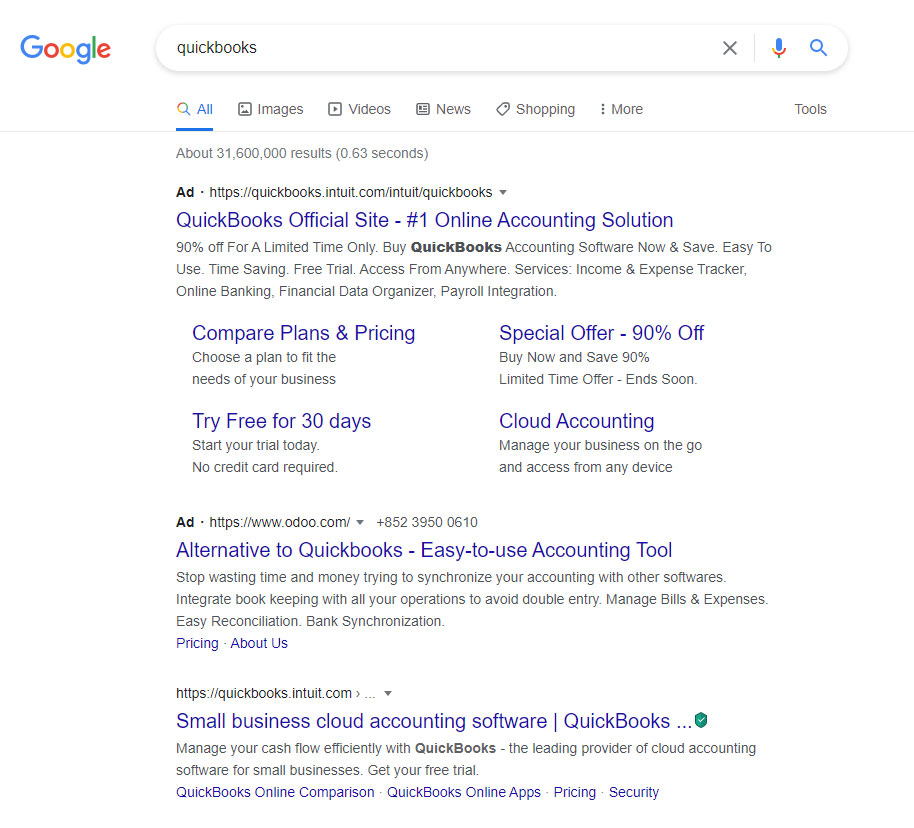Visibility is the currency of any website or online business.
And while a business can achieve ready visibility through organic searches and SEO techniques, Google Ads is a more immediate, more guaranteed way to achieve the highly coveted first spot on google ranks.
At some cost of course.
However, if you’ve kept your ear to the ground, you’ve probably heard that Google is de-emphasizing the traditional, Expanded Text Ads (ETA) option of doing Google Ads—in favor of a new approach—Responsive Search Advertisements (RSA).
But what exactly are Responsive Search Ads?
Understanding Responsive Search Ads
To understand Google’s Responsive Search Ads, let’s first brush through what it means to search—and rank—on Google.
How To Do a Search (and rank) on Google
There are two ways to rank high on Google: organic searches and Google search ads.
Suppose you Google “QuickBooks”, this is how your search results will appear on your screen.

As you can see, the first site is a Google Ad.
The second one is for a site that did not pay for a Google Ad, but wrote some good SEO-optimized content that made it rank first after the paid Google Ad. This is what is referred to as an organic search.
But our focus is on Google Ads. There are two ways of coming up with Google ads:
- Expanded Text Ads
- Responsive Search Ads
Google’s Expanded Text Ads
Since 2016, Google’s default method of doing search ads has been expanded text method.
In Expanded Text Ads, an advertiser will give Google the title of his ad and the ad’s description. Google accepts up to three title suggestions and up to two descriptions.
For these Google Ads, the advertiser will have significant control over how the ad will appear on Google. She’ll even be given a chance to preview the ad and ensure that it’s exactly how she’d wanted the ad to appear.
Let’s now look at Google’s Responsive Search Ads
Google’s Responsive Search Ad
Google’s Responsive Search Ad, introduced in 2018, works a little differently.
To create a Google Responsive Search Ad, you’ll give more suggestions for your ad title and your ad description (than are required for an Expanded Text Ad) to Google.
Subsequently, Google uses machine learning and your ad copy to automatically generate an ad message that, according to Google’s algorithm, meets the Google search needs of your browsing audience.
How Google Responsive Search Ads (RSA) Work
First, you’ll give Google your suggested ad title, ad description (the body of your copy), and a URL.
Headlines and Descriptions for a Google RSA
While 3 is the maximum title suggestion in Google’s Expanded Text Ad (ETA), it’s the minimum when it comes to Google’s Responsive Search Ad.
You can give up to 15 title suggestions, however.
And when it comes to the description for your ad copy, you can give a minimum of 2, though you’re given a limit of 4.
Then Google accomplishes an incredible mathematical feat of giving up to 40,000 different ad options with only your 15 title suggestions and 4 descriptions.
But the real mathematical miracle is that Google does all these things live.
That is, if you’re an art school and a user is browsing for “the best art college that teaches photoshop in Germany”, Google will scour through your ad and come up with an ad copy that best answers the user’s search intent.
How To Create A Responsive Search
- Go to your Google Ads Dashboard. On the left side, you’ll see the drop-down tab of “Adds and Description.”
- Create your headlines. For stellar ad performance, each headline should be unique.
- Pin relevant headline. This is optional. If you pin a headline, it means you’ll want it to appear in a specific order on Google search results.
- Fill in your ad description.
- Pin your ad description. This is also optional as well.
Comparison of Ad Features Between Responsive Search Ads and Expansive Text Ads
| Ad Feature | Responsive Search Ads | Expansive Text Ads |
| Number of headlines shown | Maximum of 3 | Maximum of 2 |
| Headline characters | 30 | 30 |
| Number of descriptions shown | Maximum of 2 | 1 |
| Description characters | 90 | 80 |
| Similarity with your ad copy | Not similar | Similar |
Tips for Optimizing Your Responsive Search Ads
You’ll find people complaining that they don’t see any difference in performance between their responsive search ads and their expansive text ads.
These tips can help boost the performance of your ad and boost your ROI.
- Use multiple headlines and descriptions: While summary is important, give Google a little bit more variety with your headlines and descriptions—something more to work with.
- For each of your headlines or descriptions, write a unique and compelling copy: Distinctiveness is crucial for both your headlines and descriptions. Google works with what you give it. Don’t give it boring, generic variants of your headline or description.
- Pin headlines and descriptions to specific positions (but do it judiciously and with an abundance of caution): With Google ads, specifically responsive search ads, if you pin certain phrases, you get the advantage of highlighting them (like limited offers).
On the other hand, you overdo it and you limit Google’s ability to generate a more adaptable and relevant search result. - Consider using Dynamic Keyword Insertion (DKI): After conducting in-depth research of your keyword, consider incorporating Dynamic Keyword Insertion into your responsive search ads.
- Test ads per ad group: Don’t be too broad with your testing. You should test a single responsive search ad per ad group. Google will automatically test different combinations of your search ad.
Why You Should Use Google Responsive Search Ads
As of February 18, 2022, the default ad type is the RSA.
But there are other reasons why you should use responsive search ads.
According to Google:
- With responsive search ads, your ad will adapt well on iPhone 5 as well as on iPhone 11. It doesn’t depend on, nor is it limited by screen size.
- Responsive search ads help you compete in more auctions.
- Responsive search ads help you tailor your Google Ads to a specific location.
- Given what you give and the whole spectrum of output possible, these Google Ads are highly efficient.
- You can also significantly boost your metrics like the number of clicks and eventual conversions.
- RSA’s improve user search experience.
How Google’s RSA’s Perform
Google Ads responsive search, according to the horse’s mouth (data by Google), gives between 5% and 15% higher Click Through Rate (CTR)—compared to Expanded Text Ads and other standard ads.
But if you have an idea of how statistics work, you’ll know that these numbers are subject to the laws of averages.
Therefore, it’ll not be impossible to get someone reporting a negative Click Through Rate even as another one is reporting a 70% increase in CTR.
That’s the reason, you should be good at optimizing RSA’s regardless of the fact that they’re the default ad type.
Turn Your Google Ad into an Actual Conversion
Advertising through responsive ads is never a silver bullet.
The average conversion rate is 4.4%.
What gives?
You have to do it well, dive deep into search analytics and draw on a wealth of digital marketing research.
At Moving Traffic Media, we help you land on the coveted first spot on search rankings and literally place the Google world at your feet.
Contact us today to learn more about what we do, over and above helping companies rank on Google.
Featured image: Freepik by Creativeart







